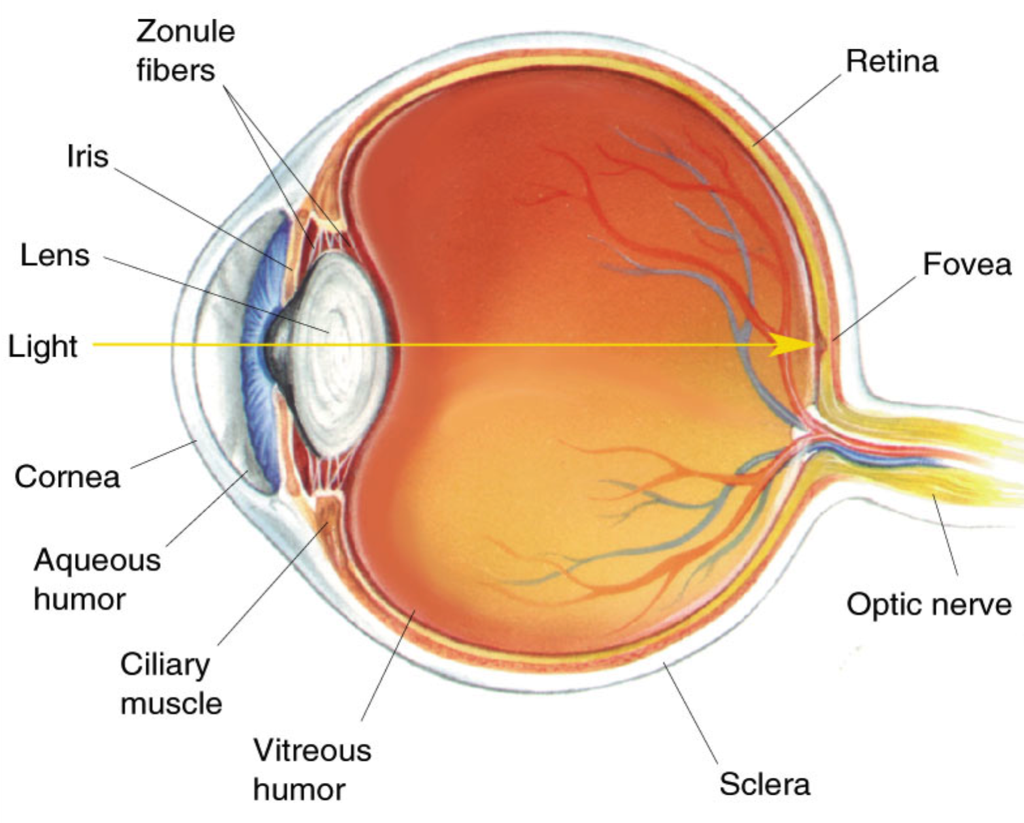Nesslig20
Active Member
I came accross this Ted talk by Erika Debeneditcs from MIT.
I know that the title seemed like almost as if she is an ID-creationist, but she is not. She has a PhD in biological engineering, focusing on synthetic biology and directed evolution to design new proteins for numerous applications. She modifies the genes of bacteria in particular and she recounts the story of having told her work to random people and the common response she gets is...well the following...
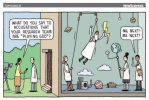
It's what is in my opinion among the most infantile arguments against...well...anything. Applying it to genetic engineering works equally well to selective breeding of crops that we have done over thousands of years...or pretty much anything we have ever done to improve our environment. How is it that building a house is not "playing god" but genetic modification is?? That's an arbitrary distinction made by people based on their subjective views of what they like and don't like. That's not to say there are no legitimate concerns, as it is the case with any technology...it's just that the "playing God" card is NOT one of these. It's not even a coherent expression if you carefully think it through.
Anyway, one of the things Erika says in her video is that biology is wonderful...but...imperfect. And we can make it better. She also explicitly expresses her position that organisms have evolved over billions of years to become as sophisticated as they are today, but as the result of unintelligent processes, biology is not perfect. She points out to a specific example which is a locus on our chromosome 9 where two critical tumor suppressor genes are present: INK4a and ARF. These genes SHARE one exon, such that if mutations occur in the shared parts, it is very likely to cause havoc. In fact, mutations within the shared exon of these genes are commonly seen in cancerous cells. Over half of human cancer cells in fact. It is a significant weak spot in our genetics that is supposed to protect us from cancer.
Obviously, by having a TEDx talk titled "It's time for intelligent design" on youtube, you will inevitable attract a certain group of people who would not be very happy to hear these things, especially if they were expecting to have their biases confirmed. And that's of course what happened. Seeing the like to dislike ratios, as well as the God-awful comments under the video, people did not like this. But then there is also this blog post by the Discovery institute on their "Evolution News" site with some credulous commentary.
The blog begins by accusing Erika of "begging the question"
But I actually want to point out that there is a common mistake made when we talk about suboptimal design. Like when we point to something that seems so ridiculous "no intelligent designer would have made this". Although, that objection is technically fallacious since that assumes we have knowledge about the potential designer, which we don't have. Perhaps the designer was incompetent, perhaps they actually DID meant to put a deliberate flaw in the system with regard to its purpose for whatever arbitrary reason....or maybe there was a team of designers who had conflicting ideas that didn't mix well...

So we shouldn't say that sub optimal design is evidence against biology being designed by an intelligence. Though, it does make the task more difficult for the ID proponents who must offer some explanations for these by knowing what the Intelligent designer's intentions were or capabilities, etc, that explains why we have these peculiar oddities in biology. For more, please watch this video which I helped with the script:
Latter the blog tries to make the association fallacy by comparing Erika with the guy who genetically engineered twin babies a few years ago to be resistant against HIV.
One last thing that I want to do is look at the other blog post on "Evolution News" by Emily Reeves which was referenced and reportedly shows why the INK4a/ARF overlapping genes is actually a good design.
INK4a has exons 1α, 2 and 3 while ARF has exons 1β and 2. The out-of-phase overlapping reading frames occur in exon 2 of both genes.
If DNA were to do something analogously, then the degeneracy of the genetic code with its 64 codons coding for 20 amino acids would be compressed into 20 codons. 1 codon for each amino acid (with some codons having 2 nucleotides, some 3), which would allow for the removal of redundant nucleotides in the protein coding sequences, reducing its "data size" (number of base pairs) but still encoding the exact same protein. Or in the case of repetitive DNA within a gene, the repetitive nucleotides could be compressed into one repeat and extra instructions could be added that "says"..."please read the last # nucleotides # times"...which would in total still take up less base pairs than it would by having all the repeats there.
Conversely, If computational data compression would do the same as overlapping genes, then in the case of overlapping genes where they are on opposite sites of the double stranded DNA, that can't happen in the computer binary code obviously (the string of one's and zero's do not physically overlap like double stranded DNA). In the case of overlapping genes where they ARE on the same strand, but having different reading frames, then something analogously in a binary code would be having different portions of the same string being translated in different frames. Here is a random string as an example (it doesn't mean anything):
Overlapping genes imposes constraints on evolution. Within the shared sequences, any change could be harmful to one or both, thereby increasing the likelihood that a mutation is harmful (as mentioned before regarding the role the overlapping INK4a/ARF genes have in the formation of cancer). So this puts a limit on how the shared sequence can be changed. The only changes within the shared portion that aren't eliminated by selection are those that are either:
1. Neutral to one gene and beneficial to the other
2. Beneficial for both
3. Neutral for both
It's possible for the mutations to have different affects in the two genes, since these have different reading frame. Because of these different reading frames, a point mutation that affects the 1st nucleotide of a codon in one gene might be the 3rd nucleotide of a codon in the other. Thus, this mutation will change the amino acid sequence of the former gene, while it could be a synonymous mutation for the other gene. And it can be the case that the mutations that occur in this region is most often synonymous in one gene, but non-synonymous in the other. This is what is meant by the "asymmetrical evolution". From the paper that was cited:
However, where Reeves goes off is when she says that the...
I don't see this in the citation that was given. The closest thing that I see is when it talks about the evolutionary origin of overlapping genes, which was discussed right at the beginning of the introduction (the section following the abstract). The proposed mechanisms that explains these overlapping genes is what is known as "overprinting". It says that one of the two overlapping genes existed before on its own, and that the newer gene originated by mutations that added and alternative open reading frame that overlaps that of the older gene. It's a form of de novo gene evolution (new genes not the result of duplication of old genes).
New genes can be continuously added along a lineage, which is most prevalent among viruses.
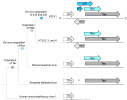
But the big question about "overprinting" is why it occurs...specifically why it is so prevalent in viruses. One hypothesis that was already previously aluded to is that virus genomes have a size constraint, thus new genes tend to evolve de novo on top of older ones. This is the gene-compression hypothesis. An alternative is the gene novelty hypothesis, proposed in this paper that was referenced by the paper Reeves cites. The gene novelty hypothesis proposes that "overprinting" is just more evolutionary convenient. In the birth of new genes, this particular evolutionary mechanisms, by forming a new reading frame on top / overlapping and older one, is simply more likely to occur. This scenario is also supported by the fact that the older gene are subject to purifying selection (as seen in INK4a), while the newer gene that was overprinted on top of the older one tends to be short, and the encoded protein tends to be intrinsically unstructured or disordered and are able to tolerate a large amount of non-synonymous mutations (as seen in ARF).
Thus it appears that Reeves has confused the cause and affect.
It is NOT that the overlapping genes function to facilitate the evolution of novel genes.
Instead
The mechanisms that facilitate the evolution of novel genes give rise to overlapping genes.
Next, Reeves cites a paper that gives some possible benefits of having this peculiar arrangement between INK4a and ARF. Here I have the full paragraph quoted:
1. Sharing of a 3'UTR region that makes the two mRNAs very stable.
2. Sharing the sequence of exon 2 causes this region to be highly sensitive to harmful mutations in order to efficiently select against them.
I want to comment on this, but I must first bring up an earlier thing that Reeves wrote:
But perhaps these genes just HAVE to be overlapping otherwise they wouldn't work....however it is possible for these genes to be separate and still working, and there actually is president for this. Other animals also have the same genes, but not every one of them as the same arrangement. It turns out that this overlap is specific to - at least - the mammals. I previously mentioned that INK4a shows signs of being the older gene whereas ARF is the one that was overprinted on it, well this is also consisted with the fact that ARF doesn't seem to be widespread among other organisms, but INK4a homologs are. In puffer fish, it has a homolog of INK4b (a paralog of INK4b that also present in mammalian genomes, and located within close proximity) but no ARF. This suggests that INK4a was the result of a tandem duplication of an ancestral INK4b. In chickens, both INK4a and INK4b sequences are observed, as well as that of ARF. However, chickens have lost the capacity to encode the protein of INK4a since exon 1α is deleted. Furthermore, the ARF protein in chickens is entirely encoded by exon 1β. This either means that ARF started out as being encoded by exon 1β and exon 2, and later in chickens, the ARF proein became encoded exclusively by exon 1β. Or, the ARF gene started out being encoded exclusively by exon 1β and later in the lineage leading to the mammals, exon 2 of INK4a became an additional exon of ARF. This study suggests the latter. In either case, the encoded portion in exon 2 (shared between the genes in mammals) is actually dispensable in order for ARF to function.
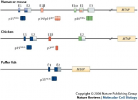
But this paper has proposed that common regulatory mechanisms for how exon 2 came to be involved in both ARF and INKa.
After all this, we still need to bear in mind that none of these propose explanation have supporting evidence aside from plausibility. Personally, I would ask the researchers to consider the possibility that there might be no special reason for having this architecture. It could very well be a the sharing of exon 2 is simply a matter of historical contingency. It could have ended up differently, as it is the case in chickens. But somewhere within our lineage, we acquired this configuration and it got stuck that way, while gaining no particular benefit from it.
But regardless of the specific explanation that we have considered, all of them proposes that this genetic architecture is the result of some evolutionary constraints...rather than any design constraints. If both genes need to be regulated by some common mechanism, than there are plenty of trans regulatory mechanisms the designer could've used as these exist for separate genes that are coordinately regulated. If both genes need a specific sequence for a stabilizing 3'UTR, there is no reason to think that a designer, who can build a genome from scratch, wouldn't be able to give two separate genes the same 3'UTR. And if the two genes need to be vulnerable to mutations for effective purifying selection, then have the genes separate but both still vulnerable to mutations, as there exists more mechanisms other than genetic overlapping.
The bottom line is this: Although this is still not certain, the genetic overlapping between INK4a and ARF may have facilitated some benefits. However, it's still possible to have the genes separate, thereby removing the big weakspot in our genetic defences against the formation of cancer, while still retaining the same benefits. In other words, none of the potential benefits that Reeves pointed to would mean that this isn't an example of sub-optimal design.
I know that the title seemed like almost as if she is an ID-creationist, but she is not. She has a PhD in biological engineering, focusing on synthetic biology and directed evolution to design new proteins for numerous applications. She modifies the genes of bacteria in particular and she recounts the story of having told her work to random people and the common response she gets is...well the following...

It's what is in my opinion among the most infantile arguments against...well...anything. Applying it to genetic engineering works equally well to selective breeding of crops that we have done over thousands of years...or pretty much anything we have ever done to improve our environment. How is it that building a house is not "playing god" but genetic modification is?? That's an arbitrary distinction made by people based on their subjective views of what they like and don't like. That's not to say there are no legitimate concerns, as it is the case with any technology...it's just that the "playing God" card is NOT one of these. It's not even a coherent expression if you carefully think it through.
Anyway, one of the things Erika says in her video is that biology is wonderful...but...imperfect. And we can make it better. She also explicitly expresses her position that organisms have evolved over billions of years to become as sophisticated as they are today, but as the result of unintelligent processes, biology is not perfect. She points out to a specific example which is a locus on our chromosome 9 where two critical tumor suppressor genes are present: INK4a and ARF. These genes SHARE one exon, such that if mutations occur in the shared parts, it is very likely to cause havoc. In fact, mutations within the shared exon of these genes are commonly seen in cancerous cells. Over half of human cancer cells in fact. It is a significant weak spot in our genetics that is supposed to protect us from cancer.
Obviously, by having a TEDx talk titled "It's time for intelligent design" on youtube, you will inevitable attract a certain group of people who would not be very happy to hear these things, especially if they were expecting to have their biases confirmed. And that's of course what happened. Seeing the like to dislike ratios, as well as the God-awful comments under the video, people did not like this. But then there is also this blog post by the Discovery institute on their "Evolution News" site with some credulous commentary.
The blog begins by accusing Erika of "begging the question"
But later we get the following:Underlying it all is the fact that DeBenedictis has simply begged the question on the nature of biological design, or lack thereof.
Like...who is actually begging the question here??In listening to rhetoric like Erika’s, I’m always put in mind of someone opening up the tower-case of a computer, disassembling it, and nonchalantly planning which bits he’s going to leave out when he reassembles it, since he can clearly perceive they’re not needed. We would fire any such technician on the spot, because it is obvious that the tower-case has been designed the way it is, with the parts it has, for a purpose. The analogy makes itself. DeBenedictis wants to fix broken stuff. But how does the saying go? If it ain’t broke, don’t fix it.
But I actually want to point out that there is a common mistake made when we talk about suboptimal design. Like when we point to something that seems so ridiculous "no intelligent designer would have made this". Although, that objection is technically fallacious since that assumes we have knowledge about the potential designer, which we don't have. Perhaps the designer was incompetent, perhaps they actually DID meant to put a deliberate flaw in the system with regard to its purpose for whatever arbitrary reason....or maybe there was a team of designers who had conflicting ideas that didn't mix well...

So we shouldn't say that sub optimal design is evidence against biology being designed by an intelligence. Though, it does make the task more difficult for the ID proponents who must offer some explanations for these by knowing what the Intelligent designer's intentions were or capabilities, etc, that explains why we have these peculiar oddities in biology. For more, please watch this video which I helped with the script:
Latter the blog tries to make the association fallacy by comparing Erika with the guy who genetically engineered twin babies a few years ago to be resistant against HIV.
And there is lots of random stuff about the seemingly anti abortion (specifically against research using embryonic tissue) and human/animal chimera research. However, there is no argument given to show that this is bad. These are just unstated and unsupported premises/conclusions throughout the blog post. I do agree that He Jiankui conducted his research unethically, mainly because he did his work in secret, misled the parents such that there was no reasonable informed consent, and his methodology was very sloppy such that it wouldn't be given a pass even if it was legal to genetically engineer human embryos. But the author of this blog is obviously pushing for the opinion that the very act of changing the genetics of humans is and will always be INHERENTLY bad...regardless of how it is conducted...which is similarly an unstated and unsupported premise/conclusion. And the fact that misconduct can happen doesn't show this. Like, if Erika was saying that we could help people by conducting medical trials to treat diseases...then someone pointing to the Tuskegee "study" to point out that misconduct is possible is similarly not a counterargument to the broad proposition that medical trials that are properly conducted are a good thing.Dr. He Jiankui didn’t think he was a mad scientist either. He just wanted to help HIV+ couples have babies without fear of passing on the curse of their infection.
But as we all know, or at least all of us except Erika DeBenedictis, not everyone’s intentions are good. There is absolutely no guarantee whatsoever that powerful bio-tech will never be turned to purposes with far more deliberate bad consequences than the purposes of a reckless young rogue scientist.
One last thing that I want to do is look at the other blog post on "Evolution News" by Emily Reeves which was referenced and reportedly shows why the INK4a/ARF overlapping genes is actually a good design.
Is the INK4a/ARF Overlap a Settled Example of Poor Design?
Reeves starts with mentioning known reasons for why different genes share the same coding sequences.Which is true in the case of viruses, where a good portion of the genome is protein coding, but in organisms us, we have a huge genome and most of our protein coding sequences are spaced pretty far apart among the sequences that don't code for proteins.To date, known functions for overlapping sequences include the data-compression hypothesis which states that dual encoding is sometimes required when there is a strong biophysical limit on genome size. (Chirico et al.)
This is a false equivalence. The "genetic compression" involves that two genes are overlapping each other by either sitting on complementary strands, going in opposite directions (5'-3'). Or they are on the same strand going in the same direction, and either the shared sequences are encoded in the same reading frame (so the overlapping genes encode for proteins which share a portion of the amino acid sequence that are identical) or the shared sequences are read in a different reading frame, as it is in the case of INK4a and ARF.Living in the digital age, we exploit the usefulness of data compression each time we compress a raw image or audio file to a JPEG or MP3. We recognize data compression as a necessary trade-off that reduces space and lowers the resources needed to transmit data.
INK4a has exons 1α, 2 and 3 while ARF has exons 1β and 2. The out-of-phase overlapping reading frames occur in exon 2 of both genes.
However, with data compression of JPEG and 3MP where...among other things....redundant data (in the case of lossless compression). That's not what is happening in the case above.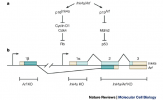
a| The two products of the mouse Ink4a/Arf locus, p16Ink4a and p19Arf (p14ARF in human) indirectly regulate the retinoblastoma protein (Rb) and p53, respectively. b | Alternative first exons (1α and 1β) that are transcribed from different promoters (arrows) specify the 5' ends of the Ink4a and Arf transcripts, respectively. These are spliced to the same acceptor site in exon 2, which is translated in alternative frames. Ink4a coding sequences in exons 1α, 2 and 3 are denoted by light shading, and Arf coding sequences in exons 1β and 2 are indicated by dark blue shading. The regions that are disrupted in the different knockout (KO) mouse strains are indicated below the figure. The schematic is not drawn to scale, and in both the human and mouse genomes, exons 1α and 1β are separated by >15 kb. (b is adapted from Ref. 14.
The discovery of ARF was surprising, because its coding sequences partially overlap with those of the INK4a gene (Fig. 1b). Indeed, much of the protein is encoded by an alternative reading frame in INK4a exon 2, from which ARF takes its name.
If DNA were to do something analogously, then the degeneracy of the genetic code with its 64 codons coding for 20 amino acids would be compressed into 20 codons. 1 codon for each amino acid (with some codons having 2 nucleotides, some 3), which would allow for the removal of redundant nucleotides in the protein coding sequences, reducing its "data size" (number of base pairs) but still encoding the exact same protein. Or in the case of repetitive DNA within a gene, the repetitive nucleotides could be compressed into one repeat and extra instructions could be added that "says"..."please read the last # nucleotides # times"...which would in total still take up less base pairs than it would by having all the repeats there.
Conversely, If computational data compression would do the same as overlapping genes, then in the case of overlapping genes where they are on opposite sites of the double stranded DNA, that can't happen in the computer binary code obviously (the string of one's and zero's do not physically overlap like double stranded DNA). In the case of overlapping genes where they ARE on the same strand, but having different reading frames, then something analogously in a binary code would be having different portions of the same string being translated in different frames. Here is a random string as an example (it doesn't mean anything):
011000100011111001000110001010101
To compress the data, one useful portion is used as this011000100011111001000110001010101
But the computer also uses another portion...separately...that partially overlaps with the previous one.011000100011111001000110001010101
I have never heard of a method like this to compress data in computers, but I am not well-versed to tell if this doesn't. Can anyone else tell??This is the case for overlapping genes that are translated from a single mRNA. This isn't the case with INK4a/ARF since these are from different reading frames and are transcribed and translated separately.Another reason for overlapping reading frames in a single transcript is coupling of transcription and translation.
This paragraph has some stuff right, but I can see that Reeves is a bit confused. She talks about what happens before and after the evolution of overlapping genes, and treats them as if they are the same. To better understand this, let's say what is correct in this paragraph.Another function of overlapping genes is to serve as gene nurseries. (Pavesi) Overlapping genes present a puzzle for natural selection as two proteins each subject to selection are encoded in the same stretch of DNA. Selective forces on one protein constrain the evolution of the other. This constraint may actually reduce the sequence search space, allowing for development of a novel gene based on existing genetic information. Interestingly, the evolution of overlapping open reading frames is often asymmetric. That means one protein’s open reading frame acquires non-synonymous changes (affecting the amino acid sequence) while the other acquires mostly synonymous mutations (leaving the amino acid sequence unaffected). This is the case for ARF and INK4a. This area is subject to a high intrinsic rate of mutation but ARF accumulates nearly all the non-synonymous mutations while INK4a is spared.
Overlapping genes imposes constraints on evolution. Within the shared sequences, any change could be harmful to one or both, thereby increasing the likelihood that a mutation is harmful (as mentioned before regarding the role the overlapping INK4a/ARF genes have in the formation of cancer). So this puts a limit on how the shared sequence can be changed. The only changes within the shared portion that aren't eliminated by selection are those that are either:
1. Neutral to one gene and beneficial to the other
2. Beneficial for both
3. Neutral for both
It's possible for the mutations to have different affects in the two genes, since these have different reading frame. Because of these different reading frames, a point mutation that affects the 1st nucleotide of a codon in one gene might be the 3rd nucleotide of a codon in the other. Thus, this mutation will change the amino acid sequence of the former gene, while it could be a synonymous mutation for the other gene. And it can be the case that the mutations that occur in this region is most often synonymous in one gene, but non-synonymous in the other. This is what is meant by the "asymmetrical evolution". From the paper that was cited:
So despite the constraint, adaptive evolution can still occur in one gene by assymetricAnd this is similarly true for the INK4a/ARF locus, wherein the mutations in the shared exon 2 are more often non-synonymous for the ARF gene and non-synonymous for the INK4a gene.A particularly interesting feature of overlapping genes is that they represent an intriguing example of adaptive conflict. Indeed, they simultaneously encode two proteins whose freedom to change is constrained by each other (Sander and Schulz, 1979; Krakauer, 2000; Peleg et al., 2004; Allison et al., 2016), which would be expected to reduce the adaptive ability of the virus (Simon-Loriere et al., 2013). We would expect, in principle, that overlapping genes are subjected to strong evolutionary constraints, as a single nucleotide substitution can impair two proteins (see the codon position “21” in Fig. 1 ). A typical example of “constrained evolution” is that occurring in Hepatitis B virus (HBV), whose short genome (3.2 kb) contains a high percentage (50%) of overlapping coding regions (Mizokami et al., 1997; Zhang et al., 2010).

Orientation of overlapping genes, with the downstream frame having a shift of one nucleotide 3′ with respect to the upstream frame. There are 3 types of codon position (cp): cp13 (bold character), in which the first position of the upstream frame overlaps the third position of the downstream frame; cp21 (underlined character), in which the second position of the upstream frame overlaps the first position of the downstream frame; cp32 (italic character), in which the third position of the upstream frame overlaps the second position of the downstream frame. Based on the genetic code, a nucleotide substitution at first codon position causes an amino acid change in 95.4% of cases, at second codon position in 100% of cases, and at third codon position in 28.4% of cases. Thus, nucleotide substitutions at the codon positions “13” and “32” are usually non-synonymous in one frame and synonymous in the other. Nucleotide substitutions at the codon position “21” are almost all non-synonymous in both frames.
However, overlapping genes can also show a less conservative pattern of change, because of a high rate of non-synonymous substitutions in one frame (positive adaptive selection) with concurrent dominance of synonymous substitutions in the other (negative purifying selection).
However, where Reeves goes off is when she says that the...
That overlapping genes imposes constraints......function of overlapping genes is to serve as gene nurseries.
...allowing for development of a novel gene based on existing genetic information.
I don't see this in the citation that was given. The closest thing that I see is when it talks about the evolutionary origin of overlapping genes, which was discussed right at the beginning of the introduction (the section following the abstract). The proposed mechanisms that explains these overlapping genes is what is known as "overprinting". It says that one of the two overlapping genes existed before on its own, and that the newer gene originated by mutations that added and alternative open reading frame that overlaps that of the older gene. It's a form of de novo gene evolution (new genes not the result of duplication of old genes).
New genes can be continuously added along a lineage, which is most prevalent among viruses.

But the big question about "overprinting" is why it occurs...specifically why it is so prevalent in viruses. One hypothesis that was already previously aluded to is that virus genomes have a size constraint, thus new genes tend to evolve de novo on top of older ones. This is the gene-compression hypothesis. An alternative is the gene novelty hypothesis, proposed in this paper that was referenced by the paper Reeves cites. The gene novelty hypothesis proposes that "overprinting" is just more evolutionary convenient. In the birth of new genes, this particular evolutionary mechanisms, by forming a new reading frame on top / overlapping and older one, is simply more likely to occur. This scenario is also supported by the fact that the older gene are subject to purifying selection (as seen in INK4a), while the newer gene that was overprinted on top of the older one tends to be short, and the encoded protein tends to be intrinsically unstructured or disordered and are able to tolerate a large amount of non-synonymous mutations (as seen in ARF).
Thus it appears that Reeves has confused the cause and affect.
It is NOT that the overlapping genes function to facilitate the evolution of novel genes.
Instead
The mechanisms that facilitate the evolution of novel genes give rise to overlapping genes.
Next, Reeves cites a paper that gives some possible benefits of having this peculiar arrangement between INK4a and ARF. Here I have the full paragraph quoted:
Basically two possibilitiesThe benefit of dual coding in the INK4a/ARF locus is enigmatic. In two other well studied mammalian dual-coding genes, GNAS1 and XBP1, overlapping reading frames are translated from a single mRNA: in GNAS1, this switch occurs by means of the use of alternative start codons (3); in XBP1, a specific endonuclease, IREI, removes a short spacer (not in multiples of three) rerouting translation between reading frames (39). A potential advantage of containing overlapping reading frames in a single transcript is transcriptional and translational coupling (40). For example, a transcript of GNAS1 carrying overlapping reading frames is expressed in a small subset of cell types (41). Upon translation, the product of one reading frame, ALEX, specifically binds to the product of the other frame, XLαs, possibly regulating the signal transduction properties of the latter (3, 42). None of these features apply to INK4a/ARF: each of the frames is translated from its own transcript whose expression is not tightly coordinated.
Yet one possible benefit of tight coupling between INK4a and ARF may be in the sharing of the 3′-UTR region. The two mRNAs exhibit extraordinary stability, which is thought to be determined primarily by 3′-end sequence elements (43). Another possibility is that the region of overlap may be sustained through evolution to promote variability to eliminate mutants (44). Whereas fragments of the gene (e.g., single coding exons) require high variability, still other fragments may be selected for lower amino acid changing substitutions. In this case, a single mutation in the region of overlap would lead to multiple amino acid substitutions, subsequently invoking an organism's surveillance mechanisms.
1. Sharing of a 3'UTR region that makes the two mRNAs very stable.
2. Sharing the sequence of exon 2 causes this region to be highly sensitive to harmful mutations in order to efficiently select against them.
I want to comment on this, but I must first bring up an earlier thing that Reeves wrote:
This isn't at all the case about the standard evolutionary framework. It might be a view that you get if you adhered to the naive "adaptationist" version of evolution, which makes you think that everything that persist is an adaptation that was the product of selection for some benefit. But that is not the view that is currently held by evolutionary biologist, at least not most of them. Reeves is also wrong that genes duplicate and evolve new functions "all the time"....like...yeah duplication is fairly common, but neo- or sub- functionalisation of the duplicate versions are rare compared to what most commonly happens, i.e. the duplicate version becomes a pseudogene. Also, just because a duplication followed by sub-functionalisation would be beneficial, that doesn't mean it will happen. Mutations (incl. duplication) don't arise out of a need or for a benefit. And that's not to mention any potential constraint on the possibility of removing the overlap via duplication and sub functionalisation. In short, this is a straw man of the "standard evolutionary models".However, just because the INK4a/ARF overlap is nonintuitive, that doesn’t mean it isn’t the best possible design. There may be good reasons for the overlap.
Indeed, this idea that the INK4a/ARF overlap is a “dumb mistake” is problematic for those committed to evolutionary explanations. According to standard models of gene evolution, genes duplicate and evolve new functions all the time. In this case, if the overlap region really is deleterious, then a duplication of this region, followed by subfunctionalization of one gene in one copy and the other gene in the duplicate, should be able to remove the overlap. At least that’s what standard stories of gene evolution tell us. Even in an evolutionary framework, the fact that the overlap persists would seem to suggest that it’s there for some functional reason and isn’t a harmful or poorly designed property of the genome.
But perhaps these genes just HAVE to be overlapping otherwise they wouldn't work....however it is possible for these genes to be separate and still working, and there actually is president for this. Other animals also have the same genes, but not every one of them as the same arrangement. It turns out that this overlap is specific to - at least - the mammals. I previously mentioned that INK4a shows signs of being the older gene whereas ARF is the one that was overprinted on it, well this is also consisted with the fact that ARF doesn't seem to be widespread among other organisms, but INK4a homologs are. In puffer fish, it has a homolog of INK4b (a paralog of INK4b that also present in mammalian genomes, and located within close proximity) but no ARF. This suggests that INK4a was the result of a tandem duplication of an ancestral INK4b. In chickens, both INK4a and INK4b sequences are observed, as well as that of ARF. However, chickens have lost the capacity to encode the protein of INK4a since exon 1α is deleted. Furthermore, the ARF protein in chickens is entirely encoded by exon 1β. This either means that ARF started out as being encoded by exon 1β and exon 2, and later in chickens, the ARF proein became encoded exclusively by exon 1β. Or, the ARF gene started out being encoded exclusively by exon 1β and later in the lineage leading to the mammals, exon 2 of INK4a became an additional exon of ARF. This study suggests the latter. In either case, the encoded portion in exon 2 (shared between the genes in mammals) is actually dispensable in order for ARF to function.

But this paper has proposed that common regulatory mechanisms for how exon 2 came to be involved in both ARF and INKa.
The last paragraph is important to note. Let's say that there is actually a common regulatory mechanism that applies at the entire locus. Thus the overprinting of ARF into this region would allow it to take advantage of an already existing regulatory framework. Instead of having the gene evolve a seperate regulatory system, it makes use of an already existing one. Something that is consistent with the view that evolution largely tends to "tinker" by making use of pre-existing systems instead of inventing whole new things (of course there are exceptions like de novo genes). This is also similarly true for the previous proposed explanations that was quoted by Reeves. The ARF gene by using exon 2 of INK4a would exploit an already existing stabilizing 3'UTR, as opposed to evolving the same 3'UTR again independently. Or the sharing of exons would make the genes vulnerable to mutation that allows for better purifying selection, as opposed to making use of different mechanisms that would have the same effect.It is therefore difficult to envisage how exon 2 could have evolved to serve the functional requirements of both INK4a and ARF. A more logical explanation would be that the transposition of exon 1β into the INK4b–INK4a locus reflects a common purpose for the encoded products or a need for coordinated regulation. Exon sharing might simply enable the transcript from exon 1β to be spliced and polyadenylated.
The evolutionary issue is how to account for the location of exon 1β, assuming that ARF gains little, if any, structural benefit from sharing the second exon with INK4a. Although the three genes are functionally intertwined through the pRb and p53 pathways, this alone should not require them to be co-localized in the genome. The other components featured in Boxes 2,3 are not as closely linked. The obvious advantage of grouping genes within a single chromosomal domain is that they can be regulated en bloc by the same chromatin-remodelling event or events.
In this context, it is interesting to ponder whether the primordial gene at the locus, INK4b, had assumed a role in tumour suppression before INK4 duplication, and that it retained this capacity despite the emergence of its more illustrious protégé, INK4a. If so, the regulatory mechanisms that we envisage acting on the entire locus might have originally applied to INK4b. The chance insertion of exon 1β between INK4b and INK4a could therefore have enabled the self-contained ARF gene to tap into an existing regulatory framework. The evolutionary benefit would be to bring a common mechanism to bear on both the INK4a–pRb and ARF–p53 axes. This would, for example, provide a convenient way to keep the 'senescence checkpoint' off in specific circumstances; for example, during development or in the self-renewal cycles of adult stem cells.
After all this, we still need to bear in mind that none of these propose explanation have supporting evidence aside from plausibility. Personally, I would ask the researchers to consider the possibility that there might be no special reason for having this architecture. It could very well be a the sharing of exon 2 is simply a matter of historical contingency. It could have ended up differently, as it is the case in chickens. But somewhere within our lineage, we acquired this configuration and it got stuck that way, while gaining no particular benefit from it.
But regardless of the specific explanation that we have considered, all of them proposes that this genetic architecture is the result of some evolutionary constraints...rather than any design constraints. If both genes need to be regulated by some common mechanism, than there are plenty of trans regulatory mechanisms the designer could've used as these exist for separate genes that are coordinately regulated. If both genes need a specific sequence for a stabilizing 3'UTR, there is no reason to think that a designer, who can build a genome from scratch, wouldn't be able to give two separate genes the same 3'UTR. And if the two genes need to be vulnerable to mutations for effective purifying selection, then have the genes separate but both still vulnerable to mutations, as there exists more mechanisms other than genetic overlapping.
The bottom line is this: Although this is still not certain, the genetic overlapping between INK4a and ARF may have facilitated some benefits. However, it's still possible to have the genes separate, thereby removing the big weakspot in our genetic defences against the formation of cancer, while still retaining the same benefits. In other words, none of the potential benefits that Reeves pointed to would mean that this isn't an example of sub-optimal design.
Last edited:


